Men go back to the mountains, as they go back to sailing ships at sea, because in the mountains and on the sea they must face up, as did men of another age, to the challenge of nature. Modern man lives in a highly synthetic kind of existence. He specializes in this and that. Rarely does he test all his powers or find himself whole. But in the hills and on the water the character of a man comes out.
Abram T. Collier
While none can argue that the rapid advances in technology over the last century have drastically improved the lives of modern men, there are negative consequences that also accompany these advancements. For the average man, it is often the case that as our technology has increased, our knowledge has subsequently decreased. The skills that were known to every man just two or three generations back have withered, and technology has become a crutch. The advent of the internet and the all powerful Google has put worlds of knowledge at our fingertips, but as information becomes more and more readily available, man has no motivation to retain it within himself.
The real problem is not whether machines think but whether men do.
B.F. Skinner
While the positive aspects this unprecedented access to knowledge surely outweigh the negatives, there is something to be said for retaining some of the skills of yesteryear. It is with that in mind that we turn our attention to relearning the use of an old tool, one which guided men through the darkest jungles and the most unforgiving seas for generations…the compass. In the following sections we will review the construction and handling of the compass and will examine the technique for basic compass-based navigation.
Basic Styles
While there are several variations of the compass available, two models stand out as the standard equipment for hikers and other outdoorsmen: the baseplate compass and the lensatic compass.
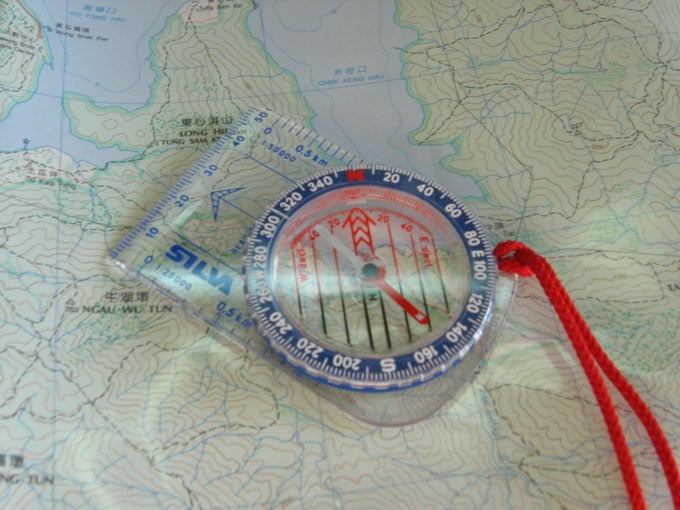
Baseplate Compass

Lensatic Compass
Both styles rose in prominence during World War II, with the lensatic model becoming U.S. Army standard issue during that time and remaining so today. The instructions for use that follow will be based on the lensatic model, since it is the more durable of the two. However, the basic concepts involved in navigation by compass apply to both models.
Breaking It Down
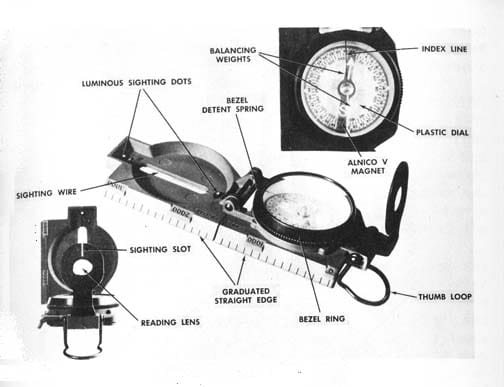
At first glance, the lensatic compass can seem a bit daunting. Covered in various markings and with multiple moving parts, it looks as though it demands a high level of skill to operate. Quite to the contrary, with a little bit of knowledge of the basic functions, anyone can work a lensatic like a pro.
There are three main parts to the lensatic compass; the cover, the base, and the reading lens. The cover is essentially the lid, and contains the sighting wire. The base is the bottom half of the compass, and contains the floating compass dial (with markers for South, East, and West and an arrow pointing North), the bezel that surrounds it, and the thumb loop. The dial itself is actually floating in liquid, usually kerosene or a type of oil. Protecting the dial is a glass cover with a fixed index line etched into it. There is also a smaller line on the lens that rotates with the bezel. The reading lens is mounted in a moveable arm attached to the base of the compass, and folds to lay flat on the dial for protection when the compass is closed.
How to Hold the Compass
Using proper technique when holding the compass is critical, since an improper hold will result in a bad reading, potentially leaving you lost in the wild. There are two predominant techniques for properly handling a lensatic compass when taking a reading; the centerhold technique and the compass-to-cheek technique.
The Centerhold Technique
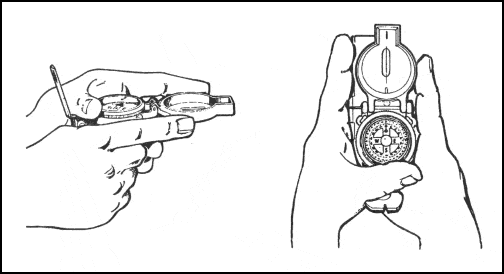
To properly execute the centerhold technique, you need to open the compass a full 180 degrees, so that if you were to lay it on a table both the base and cover would lie flat on the table surface. Now fold the thumb loop to its fully opened position and grasp the compass as shown in the diagram above. As you stand with your elbows tight at your sides, the compass should be held out in front of your midsection. To take a reading, point your entire body at a target object in the distance while holding this stance. Once you are centered in on the object, look down and take note of the degree marked underneath the fixed index line on the dial.
The Compass to Cheek Technique
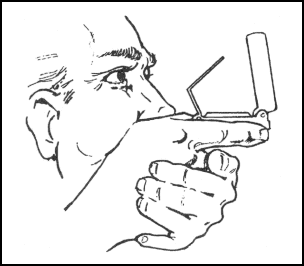
The name alone leaves little to the imagination, and combined with the above picture, this technique is virtually self-explanatory. With the cover opened up to 90 degrees and the reading lens opened to 45 degrees, fold the thumb hook to its fully opened position. Place your thumb inside the thumb hook and grasp the compass with a grip as shown above.
To Take a Bearing
Grasp the compass with your preferred grip. Locate the target object (distant mountain, radio tower, etc) you will be using for a bearing. If you are using the centerhold technique, point the compass at the target. If you are using the compass to cheek technique, locate the object by looking through the sighting wire, centering the sighting wire on your target. While holding this position, take note of the degree mark.
Navigating with Your Compass
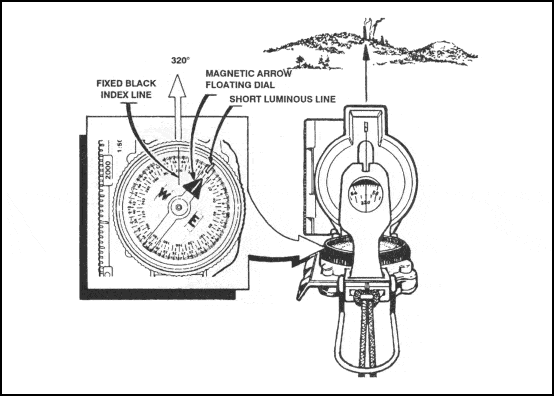
Once you have noted the degree mark, rotate the bezel until the moveable line etched into the glass lies directly in line with the north directional arrow. You have now oriented yourself. Regardless of visibility, you will always know that when the north arrow is lined up with this line, your target object is in the direction of the sighting wire. Be sure to retake your bearings whenever you can, so as to leave as little room for error as possible.
Other Things to Keep in Mind
- Always remember that since a compass takes its readings from magnetic energy, it can be affected by metal objects nearby. For example, if you’re standing with a kit full of metal tent poles on your back trying to take a reading, you may get a false north and end up walking laps around Yellowstone all day.
- Be aware of high tension power lines, making sure to be at least 50 yards away from them when taking a bearing.
- Always check to make sure that your compass dial is able to move freely and that your compass is free of any damage that may interfere with readings.
Of course, this is just an introduction into what you can do with a combination of a compass and proper training. A detailed guide to more advanced compass techniques can be found in any Army Field Manual, available online or at your local bookstore. Keep in mind that while a GPS unit is very handy, circuit boards do short circuit and batteries do run down, and when they do, you’ll be glad to have your trusty compass in hand to guide you home.
: United States Department of the Army Field Manual No. 3-25.26


